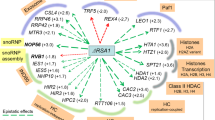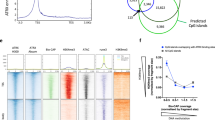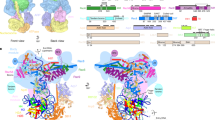Abstract
The tumor suppressor Arf (Alternative Reading Frame) protein (p14ARF in human and p19ARF in mouse) is mainly located in the nucleolus consistent with its subcellular localization, the protein has been shown to specifically interact with 5.8S rRNA and with B23/Nucleophosmin and to regulate ribosome biogenesis. Here, we show that the p14ARF protein interacts with chromatin and is recovered by chromatin immunoprecipitation (ChIP) in a fraction that contains a DNA sequence of the rRNA gene promoter. In addition, topoisomerase I (Topo I) that has been shown to interact with p14ARF coprecipitates with p14ARF containing chromatin. These data, in view of the function for Topo I in rRNA transcription, are consistent with a role for the p14ARF-Topo I complex in rRNA transcription and/or maturation.
This is a preview of subscription content, access via your institution
Access options
Subscribe to this journal
Receive 50 print issues and online access
$259.00 per year
only $5.18 per issue
Buy this article
- Purchase on Springer Link
- Instant access to full article PDF
Prices may be subject to local taxes which are calculated during checkout





Similar content being viewed by others
References
Arnan C, Saperas N, Prieto C, Chiva M and Ausio J . (2003). J. Biol. Chem., 278, 31319–31324.
Ayrault O, Karayan L, Riou JF, Larsen CJ and Séité P . (2003). Oncogene, 22, 1945–1954.
Boon K, Caron HN, Van Asperen R, Valentijn L, Hermus MC, Van Sluis P, Roobeek I, Weis I, Voute PA, Schwab M and Versteeg R . (2001). EMBO J., 20, 1383–1393.
Burke TW, Cook JG, Asano M and Nevins JR . (2001). J. Biol. Chem., 276, 15397–15408.
Carnero A, Hudson JD, Price CM and Beach DH . (2000). Nat. Cell Biol., 2, 148–155.
Della Valle V, Duro D, Bernard O and Larsen CJ . (1997). Oncogene, 15, 2475–2481.
Eisenman RN . (2001). Genes Dev., 15, 2023–2030.
Eymin B, Karayan L, Séité P, Brambilla C, Brambilla E, Larsen CJ and Gazzeri S . (2001). Oncogene, 20, 1033–1041.
Eymin B, Leduc C, Coll JL, Brambilla E and Gazzeri S . (2003). Oncogene, 22, 1822–1835.
Garg LC, DiAngelo S and Jacob ST . (1987). Proc. Natl. Acad. Sc. USA, 84, 3185–3188.
Gladden AB and Diehl JA . (2003). J. Biol. Chem., 278, 9754–9760.
Honda R and Yasuda H . (1999). EMBO J., 18, 22–27.
Itahana K, Bhat KP, Jin A, Itahana Y, Hawke D, Kobayashi R and Zhang Y . (2003). Mol. Cell, 12, 1151–1164.
Jackson DA and Cook PR . (1985). EMBO J., 4, 919–925.
Jackson DA, Hassan AB, Errington RJ and Cook PR . (1993). EMBO J., 12, 1059–1065.
Kamakaka RT and Thomas JO . (1990). EMBO J., 9, 3997–4006.
Karayan L, Riou JF, Séité P, Migeon J, Cantereau A and Larsen CJ . (2001). Oncogene, 20, 836–848.
Korgaonkar C, Zhao L, Modestou M and Quelle DE . (2002). Mol. Cell. Biol., 22, 196–206.
Llanos S, Clark PA, Rowe J and Peters G . (2001). Nat. Cell. Biol., 3, 445–452.
Lowe SW and Sherr CJ . (2003). Curr. Opin. Genet. Dev., 13, 77–83.
Pomerantz J, Schreiber-Argus N, Liegeois NJ, Silverman A, Alland L, Chin L, Potes J, Chen K, Orlow I, Lee HW, Cordon-Cardo C and DePinho RA . (1998). Cell, 92, 713–723.
Pourquier P, Kohlhagen G and Urasaki Y . (2001). Proc. Am. Assoc. Cancer Res., 42, 303.
Quelle DE, Zindy F, Ashmun RA and Sherr CJ . (1995). Cell, 83, 993–1000.
Reyes JC, Muchardt C and Yaniv M . (1997). J. Cell. Biol., 137, 263–274.
Rose SM and Garrard WT . (1984). J. Biol. Chem., 259, 8534–8544.
Rossi F, Labourier E, Forné T, Divita G, Derancourt J, Riou JF, Antoine E, Cathala G, Brunel C and Tazi J . (1996). Nature, 381, 80–82.
Sherr CJ . (2001). Nat. Rev. Mol. Cell. Biol., 2, 731–737.
Smith HC and Rothblum LI . (1987). Biochem. Genet., 25, 863–879.
Sugimoto M, Kuo ML, Roussel MF and Sherr CJ . (2003). Mol. Cell, 11, 415–424.
Vaughn JL, Goodwin RH, Tompkins GJ and McCawley P . (1977). In Vitro, 13, 213–217.
Wadhwa R, Sugihara T, Hasan MK, Taira K, Reddel RR and Kaul SC . (2002). J. Biol. Chem., 277, 36665–36670.
Weber JD, Jeffers JR, Rehg JE, Randle DH, Lozano G, Roussel MF, Sherr CJ and Zambetti GP . (2000). Genes Dev., 14, 2358–2365.
Zhang H, Wang JC and Liu LF . (1988). Proc. Natl. Acad. Sci. USA, 85, 1060–1064.
Zhang Y, Xiong Y and Yarbrough WG . (1998). Cell, 92, 725–734.
Acknowledgements
This work was supported by a Grant from the ‘Ligue contre le Cancer, comité de la Vienne’. We are grateful to Dr Annick Harel-Bellan who welcomed O Ayrault in her laboratory and to Irina Naguibneva who provided precious help and advices for ChIP technique. L Andrique is currently supported by a grant from the ‘Ligue Nationale Contre le Cancer’. We also wish to thank the ‘Société française du Cancer’ for financial support of O Ayrault during his stay in Dr Harel-Bellan laboratory.
Author information
Authors and Affiliations
Corresponding author
Rights and permissions
About this article
Cite this article
Ayrault, O., Andrique, L., Larsen, CJ. et al. Human Arf tumor suppressor specifically interacts with chromatin containing the promoter of rRNA genes. Oncogene 23, 8097–8104 (2004). https://doi.org/10.1038/sj.onc.1207968
Received:
Revised:
Accepted:
Published:
Issue Date:
DOI: https://doi.org/10.1038/sj.onc.1207968
Keywords
This article is cited by
-
The ARF tumor-suppressor controls Drosha translation to prevent Ras-driven transformation
Oncogene (2014)
-
ARF stimulates XPC to trigger nucleotide excision repair by regulating the repressor complex of E2F4
EMBO reports (2009)
-
Human tumor suppressor p14ARF negatively regulates rRNA transcription and inhibits UBF1 transcription factor phosphorylation
Oncogene (2006)
-
Divorcing ARF and p53: an unsettled case
Nature Reviews Cancer (2006)
-
DNA damage, p14ARF, Nucleophosmin (NPM/B23), and cancer
Journal of Molecular Histology (2006)



